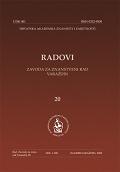VARAŽDINSKI PERIVOJI 19. STOLJEĆA U HRVATSKOM I EUROPSKOM KONTEKSTU
VARAŽDIN’S PARKS OF THE 19TH CENTURY IN CROATIAN AND EUROPEAN CONTEXT
Author(s): Bojana Bojanić, Mladen Obad ŠćitarociSubject(s): Architecture
Published by: Hrvatska akademija znanosti i umjetnosti - Zavod za znanstveni rad Varaždin
Keywords: Varazdin; parks; promenades; 19th century; historicism; gardens on city fortifications
Summary/Abstract: This work describes the cultural landscape of the 19th Century Varazdin in the atmosphere of park’s creation in Croatia and Europe. The first public parks in Croatia appear in the 18th Century in Osijek (City Garden around 1750.), Zagreb (Maksimir Baroque era Bishop Maximilian Vrhovac) and Varazdin, at the same time as in European cities. Varaždin’s public parks of the 19th Century: Prater, Anthony Pusta Park and Promenade, are placed in temporal context with other Croatian and European public urban parks. Prater or Graberje was a first public park in Varazdin. It was constructed on the western city fortification in the late 18th Century (1799). The Park Antun Pust from the 1829th was intended for public enjoyment and recreation of the citizens. In the Bavarian journal Algemeine Garten Deutsche Zeitung (No. 3, 1829), Michael Kunich describes the park as a distinctive, beautiful and comfortable, uncommon triangular ground plan with long arms, a beech avenue in the middle.
Journal: Radovi Zavoda za znanstveni rad Varaždin
- Issue Year: 2013
- Issue No: 24
- Page Range: 293-316
- Page Count: 24
- Language: Croatian

